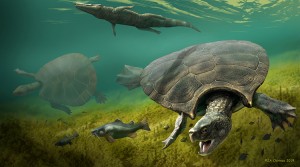Stupendemys the Titanic Turtle
March 30, 2020
Some 15 million years ago, long after the non-bird dinosaurs and the beasts they lived alongside had gone extinct, giant creatures still walked (or swam) the Earth. Recently, the discoveries of a team of scientists led by Edwin Cadena of Del Rosario University in Colombia have been putting more of a face—or a shell, in this case—on one of these ancient giants. And, not only did the giant have a shell, but the shell had spikes! Meet Stupendemys, the titanic turtle.

Stupendemys lived during the Miocene Epoch, around 23 million to 5.3 million years ago. credit: © Jaime Chirinos
The giant aquatic (water-dwelling) Stupendemys had a big head with a sharp beak. It had four paddlelike limbs and a short tail. It probably could not withdraw its head or limbs into its large shell, as can many turtles. Its shell alone measured about 8 feet (2.4 meters) long. Stupendemys weighed about 2,500 pounds (1,150 kilograms). It and the prehistoric marine turtle Archelon were the largest turtles known to have ever lived.
Stupendemys had been known since the 1970’s from huge pieces of shells and limb bones, but no cranial (skull) material had been positively identified. Cadena’s new trove of Stupendemys fossils included skull fragments, however. Found in Colombia and neighboring Venezuela, the skull pieces matched those of previously unidentified ancient turtle remains discovered in other parts of South America, showing that Stupendemys was fairly widespread.
Some of the Stupendemys shells found by Cadena and his team had large forward-pointing horns at the shoulders. The scientists believe this is a case of sexual dimorphism. Sexual dimorphism is a difference in body size or shape between males and females of the same species. Males probably used these horns in combat over mates and territory. Deep gouges were often found near the Stupendemys shell horns, suggesting that males literally locked horns when fighting.
Stupendemys was not the top boss of South American waterways during the Miocene Epoch, a time in Earth’s history that lasted from 23 million to 5.3 million years ago. The turtle was likely a gentle giant, surviving on a diet of hard-shelled mollusks, fruits, and seeds. And its huge size did not grant it complete protection from predators. Giant crocodilians prowled the region at that time, including the 40-foot (12.5-meter) giant caiman Purussaurus. One Stupendemys shell found by Cadena’s team contained an embedded crocodilian tooth! It’s hard to say who came out on top in that encounter, but it was likely an epic struggle.


